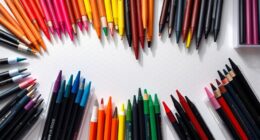If you want to stay ahead in fashion, I recommend checking out the Global Fashion Atlas, which offers detailed insights into regional styles and trends. The Vogue Style Atlas provides cultural depth and current streetwear highlights. The Fashion Trend Repository covers traditional and modern blends, while the World Style Map shows evolving fashion in various locations. Keep exploring the options, and you’ll discover which resource best fits your style-savvy needs.
Key Takeaways
- Prioritize atlases with comprehensive geographic coverage, including diverse regions, cities, and cultural styles for global fashion insights.
- Choose resources offering diverse design styles, durable materials, and seasonal or occasion-specific fashion representations.
- Opt for cost-effective atlases that balance detailed, accurate data with affordability and long-term usability.
- Select platforms with intuitive interfaces, advanced search filters, visual aids, and regular updates for easy navigation and current trends.
- Ensure the atlas supports business needs with relevant, up-to-date information and features that facilitate strategic fashion decision-making.
Vintage World Atlas Micro Fleece Blanket, All-Season Couch Throw 60″x50

Looking for a cozy, versatile blanket that combines style with comfort? The Vintage World Atlas Micro Fleece Blanket is perfect. Made from ultra-soft anti-flannel microfleece, it feels lush and warm against your skin. Its vintage map design on one side adds a unique touch to any space, while the white interior keeps it simple and clean. Sized at 60″ x 50″, it’s ideal for lounging on the couch, bed, or even traveling. Lightweight and easy to care for, it’s suitable for all seasons—keeping you warm in winter and cool in summer. Plus, it makes a thoughtful gift for any adventure or travel enthusiast.
Best For: those seeking a stylish, cozy, and versatile blanket perfect for relaxing at home or on the go.
Pros:
- Ultra-soft anti-flannel microfleece fabric provides maximum comfort and a cozy feel
- All-season design suitable for warmth in winter and coolness in summer
- Lightweight and portable, ideal for travel, camping, or outdoor activities
Cons:
- May arrive with wrinkles due to vacuum packaging, requiring smoothing out
- Single-sided print means the vintage map design is only visible on one side
- Not suitable for heavy-duty use or extreme cold conditions
Gellen Gel Nail Polish Remover, 2 pcs

If you’re someone who values quick, gentle, and convenient nail polish removal, the Gellen Gel Nail Polish Remover (2 pcs) is an excellent choice. It’s a fast-acting, no-foil gel remover that easily takes off gel polish, nail glue, and acrylics. Each bottle contains 18ml, perfect for both professional salons and DIY at home. Simply apply a thick layer with the brush, wait 2-5 minutes, then wipe away the softened gel—no soaking or scraping needed. It’s gentle on natural nails, helping prevent damage, and is safe for frequent use. Compact and travel-friendly, this remover makes nail changes quick and hassle-free wherever you are.
Best For: individuals seeking a gentle, quick, and convenient gel nail polish removal method suitable for both professional and DIY use.
Pros:
- Fast-acting formula that breaks down gel polish in just 2-5 minutes.
- Gentle on natural nails, reducing damage compared to traditional acetone soaking.
- Portable, lightweight, and easy to use anywhere, perfect for travel and beginners.
Cons:
- May require multiple applications for very thick or stubborn gel layers.
- Does not include a foil wrap or extra tools for enhanced removal.
- Needs to be applied carefully to avoid contact with eyes, mouth, or skin.
Peel Off Gel Base Coat for Nails

Peel Off Gel Base Coat is perfect for anyone seeking a quick, damage-free way to switch nail styles. It allows easy removal without buffing or soaking, so you can change your look effortlessly. The formula is toxin-free, vegan, cruelty-free, and has a lower odor than traditional polishes, making it safer and more environmentally friendly. No UV or LED curing is needed; it air-dries in just 1-2 minutes. Simply apply a thin layer, add your color, and peel off when ready. This base coat is ideal for beginners, nail art lovers, or anyone who wants stylish nails without the damage or hassle of traditional gels.
Best For: those seeking a quick, damage-free, and eco-friendly way to change nail styles easily without the need for curing or harsh removal methods.
Pros:
- Easy to remove without buffing, soaking, or damaging natural nails
- Toxin-free, vegan, cruelty-free, and lower odor than traditional polishes
- No UV/LED curing needed; air-dries in 1-2 minutes
Cons:
- May last around 5 days, which is shorter than traditional gel manicures
- Requires careful application to prevent peeling or shrinking
- Needs gentle filing before removal to ensure clean peel-off
Factors to Consider When Choosing Global Fashion Atlas

When selecting a global fashion atlas, I consider factors like geographic coverage to verify it includes the regions I care about. I also look at how accurately it represents different cultures and the variety of styles it offers. Finally, I weigh its durability and price to find the best balance of quality and value.
Geographic Coverage Area
Considering the geographic coverage area is essential when selecting a global fashion atlas because it determines the breadth and relevance of the data you’ll access. I look for an atlas that includes a thorough list of countries and regions relevant to my needs, ensuring I don’t miss key markets. It’s important that the coverage spans both major cities and rural areas, offering detailed insights across different environments. I also verify that maps are current, reflecting recent political or geographical changes, so my strategies stay accurate. Including specific zones like islands, mountain ranges, or coastal regions helps me understand niche markets. Ultimately, I choose an atlas whose scope aligns with my target audience and areas of interest, giving me a complete picture of the global fashion landscape.
Cultural Representation Accuracy
Ensuring cultural representation accuracy is vital when choosing a global fashion atlas because it directly affects how authentically and respectfully diverse fashion traditions are portrayed. Accurate depictions of styles, symbols, and traditional attire require verifying their cultural and historical significance, helping to avoid misinterpretation or stereotyping. Relying on reliable sources and collaborating with cultural experts can considerably boost authenticity. Proper representation fosters appreciation and understanding, preventing cultural misappropriation or misrepresentation. It’s essential that the atlas prioritizes data accuracy and sensitivity, guaranteeing that cultures are depicted with respect and nuance. By choosing an atlas committed to cultural integrity, you guarantee that the fashion insights you gain are both genuine and respectful, ultimately enriching your understanding of global styles.
Design and Style Diversity
A truly exhaustive global fashion atlas should showcase a rich tapestry of design styles from around the world, reflecting both traditional roots and modern innovations. I look for an atlas that features a wide array of cultural and regional styles, blending classic and contemporary trends to appeal to diverse tastes. Variations in color palettes, patterns, and fabric choices add depth and vibrancy, capturing the essence of each culture’s aesthetic. It’s essential that the atlas covers seasonal and occasion-specific styles, offering a comprehensive view of fashion’s versatility. Including avant-garde and innovative designs alongside timeless classics enriches the overall diversity, ensuring I stay inspired and ahead of trends. A diverse design collection truly captures the global fashion landscape in all its richness.
Material and Durability
Choosing the right material for a global fashion atlas is essential because it determines how well the book holds up over time and in different environments. I look for atlases made from durable fabrics and sturdy bindings that resist wear and tear, ensuring they stay intact with frequent use. Weather-resistant or water-repellent materials are a bonus, protecting the atlas from moisture in various climates. Eco-friendly dyes are also important, as they keep the print vibrant and safe for the environment. A well-constructed atlas with reinforced edges and binding helps prevent tearing and page damage, even with regular handling. Ultimately, quality materials guarantee your atlas remains a reliable, long-lasting resource for staying ahead in fashion trends.
Price and Value
When selecting a global fashion atlas, evaluating its price relative to the value it provides is key. I look for an atlas that offers thorough coverage and accurate data without overcharging. It’s important to compare features and insights with other industry resources at similar prices to ensure I get good bang for my buck. I also consider extra benefits like regularly updated data, an intuitive interface, and supplementary content that enhances the overall value. I check whether the cost covers ongoing updates or if there are additional fees for new editions or datasets. Ultimately, I want my investment to support my specific fashion research or business needs effectively and affordably, ensuring I stay ahead without overspending.
Ease of Use
Since ease of use directly impacts how efficiently I can access and interpret data, I prioritize a global fashion atlas with a clear, intuitive interface. I look for platforms that allow me to navigate quickly and find information effortlessly. Straightforward search functions, like filters by region, trend, or time period, make data access simple and save time. Visual aids such as maps, charts, and icons help me understand complex trends at a glance without needing extra explanation. It’s also important that user instructions and help features are easy to find, especially if I’m new to the platform. Consistent updates and real-time data guarantee I always have accurate, current insights, making the atlas both reliable and practical for staying ahead in fashion.
Frequently Asked Questions
How Often Are Global Fashion Atlases Updated?
Global fashion atlases are typically updated twice a year, aligning with the fashion industry’s seasonal cycle. I find this frequency helps me stay current with emerging trends, runway shows, and key style movements. Some sources update more frequently, especially online platforms, while printed editions might follow a slower schedule. Regular updates guarantee I’m in the know about global fashion shifts, helping me stay ahead and make informed style choices.
Which Regions Are Most Influential in Fashion Trends?
Like a modern-day Marie Antoinette, I believe the most influential regions in fashion are New York, Paris, Milan, and London. These cities set the trends that ripple worldwide, shaping everything from runway shows to street style. Their designers, influencers, and cultural hubs drive innovation and inspire global fashion movements. Staying attentive to these regions keeps me ahead of the curve, ensuring I catch the latest styles before they hit mainstream streets.
Can a Fashion Atlas Predict Future Style Movements?
Yes, a fashion atlas can help predict future style movements. I use it to spot emerging trends, analyze regional influences, and understand global shifts. It’s like having a sneak peek into what’s coming next in fashion. While it’s not foolproof, I find it incredibly useful for staying ahead of the curve and adapting my style before trends become mainstream. It’s a valuable tool for any fashion enthusiast.
Are Digital or Printed Atlases More Popular Among Designers?
Back in the day, printed atlases reigned supreme, but now I find digital fashion atlases more popular among designers. They’re instantly accessible, easy to update, and perfect for the fast-paced fashion world. Plus, I can explore trends on the go, just like I’d scroll through my favorite social media feeds. Digital tools keep me connected and inspired, making them my top choice in today’s ever-evolving style scene.
How Do Cultural Differences Influence Global Fashion Insights?
Cultural differences greatly shape global fashion insights by influencing color choices, fabrics, and styles that resonate locally. I find that understanding these nuances helps me create designs that connect authentically with diverse audiences. By studying regional traditions, festivals, and social norms, I stay ahead in style trends. Embracing cultural diversity enriches my perspective, ensuring my collections are both innovative and respectful of global tastes.
Conclusion
As I was exploring these fashion atlases, I realized they’re more than just guides—they’re like discovering a hidden thread connecting global styles. Sometimes, it feels like fate led me here, finding the perfect resource just when I needed a fresh perspective. Staying ahead in fashion isn’t about luck, but about embracing these tools that subtly shape our style journey. Trust me, once you start, you’ll see how beautifully interconnected our world truly is.









